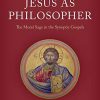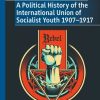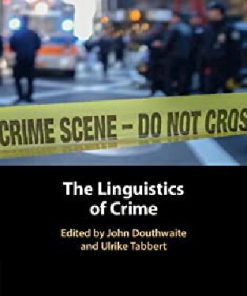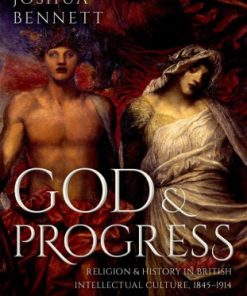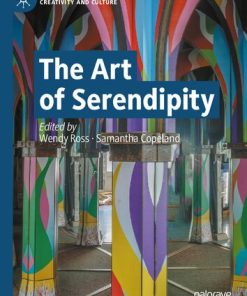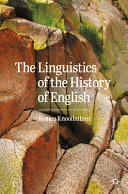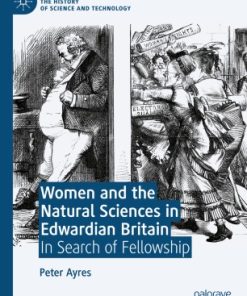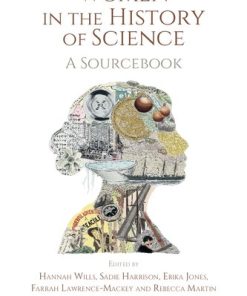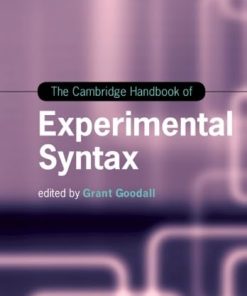(Ebook PDF) Women in the History of Linguistics 1st edition by Wendy Ayres Bennett, Helena Sanson 0191071129 9780191071126 full chapters
$50.00 Original price was: $50.00.$25.00Current price is: $25.00.
Women in the History of Linguistics 1st edition by Wendy Ayres-Bennett, Helena Sanson – Ebook PDF Instant Download/DeliveryISBN: 0191071129, 9780191071126
Full download Women in the History of Linguistics 1st edition after payment
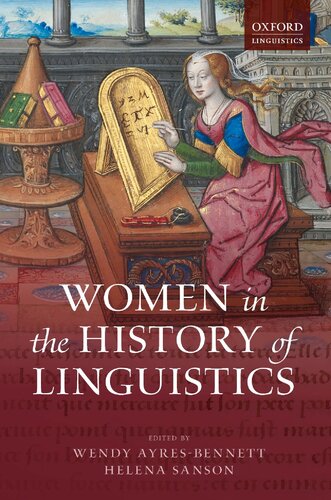
Product details:
ISBN-10 : 0191071129
ISBN-13 : 9780191071126
Author: Wendy Ayres-Bennett, Helena Sanson
Women in the History of Linguistics is a ground-breaking investigation into women’s contribution to the description, analysis, and codification of languages across a wide range of different linguistic and cultural traditions. Notably, the volume looks beyond Europe to Africa, Australia, Asia, and North America, offering a systematic and comparative approach to a subject that has not yet received the scholarly attention it deserves. In view of women’s often limited educational opportunities in the past, their impact is examined not only within traditional and institutional contexts, but also in more domestic and less public realms. The chapters explore a variety of spheres of activity, including the production of grammars, dictionaries, philological studies, critical editions, and notes and reflections on the nature of language and writing systems, as well as women’s contribution to the documentation and maintenance of indigenous languages, language teaching and acquisition methods, language debates, and language use and policy. Attitudes towards women’s language-both positive and negative-that regularly shape linguistic description and analysis are explored, alongside metalinguistic texts specifically addressed to them as readers. Women in the History of Linguistics is intended for all scholars and students interested in the history of linguistics, women’s studies, social and cultural history, and the intersection between language and gender
Women in the History of Linguistics 1st Table of contents:
1. Introduction
2. Previous studies of women in the history of linguistics
3. Why are women so little represented in classic works on the history of linguistics?
4. Challenges and opportunities for women in the history of linguistics
5. Moving beyond the European and the Western
6. Chronological scope of the volume
7. Recurring themes
7.1 Women’s language
7.2 Women and language acquisition and teaching
7.3 Women as creators of new languages and scripts
7.4 Women as dedicatees, patrons, and intended readers of metalinguistics texts
7.5 Women as authors of metalinguistic texts
7.6 Women as interpreters and translators
7.7 The role of women in language documentation, preservation, and folklore
7.8 Women supporting male relatives and colleagues
7.9 Women breaking into institutionalized contexts
8. Future perspectives
Acknowledgements
1: Visible and invisible women in ancient linguistic culture
1.1 Introduction
1.2 Education in Archaic (700–500 …) and Classical (480–330 …) Greece
1.3 Women poets from Archaic and early Classical Greece
1.4 Pythagorean women philosophers
1.5 Women in Plato’s philosophical circle
1.6 Hellenistic philosophers and learned women (330–27 …)
1.7 Women’s literacy and education in the Hellenistic period
1.8 Language arts: Philology
1.9 Women teachers and grammarians in Hellenistic times
1.10 Language arts and education in Rome
1.11 Schools of grammar and rhetoric in Rome
1.12 Women’s virtues
1.13 Standard prejudices towards learned women
1.14 Women philosophers in late antiquity
1.15 Conclusion
2: Women and language codification in Italy: Marginalized voices, forgotten contributions
2.1 Introduction
2.2 The sixteenth and seventeenth centuries
2.2.1 Ideas about language use
2.2.2 Women, the literary language, and its grammar
2.2.3 Women translators
2.3 The eighteenth century
2.3.1 Ideas on women’s language
2.3.2 Women and grammar production
2.3.3 Translation as scholarship
2.4 The nineteenth century and the post-Unification period
2.4.1 Women as ‘teachers’ of Italian
2.4.2 Women as grammarians
2.4.3 Women as collectors and scholars of language
2.4.4 Women and lexicography
2.4.5 Women and the academies: Official recognition
2.5 Concluding remarks
3: Women as authors, audience, and authorities in the French tradition
3.1 Introduction
3.2 Metalinguistic texts
3.2.1 Women as authors of metalinguistic texts
3.2.2 Women as dedicatees of metalinguistic texts
3.2.3 Women as the intended audience of metalinguistic texts
3.3 Women as translators of literary or scientific texts
3.4 Women’s education, the teaching of grammar and of foreign languages
3.4.1 Women’s educational opportunities
3.4.2 Teaching French grammar to girls
3.4.3 Women and the learning of modern languages
3.5 Discussions of women’s language
3.6 Concluding remarks
4: The contribution of women to the Spanish linguistic tradition: Four centuries of surviving words
4.1 Introduction
4.2 Sixteenth and seventeenth centuries: The role of women in the early codification of Spanish
4.2.1 The passion for classical languages: The puellae doctae
4.2.2 Women writing in the vernacular: Dignifying Spanish
4.2.2.1 Conventual writing or the limits of words
4.2.2.2 The creators of fiction: The observatory of linguistic reality
4.3 Eighteenth century: Enlightened women
4.3.1 Cultivating intelligence in society: The ‘art of speaking’
4.3.2 Cultivating intelligence in the private sphere
4.3.2.1 Women as readers: Language and the female press
4.3.2.2 Women as writers: Translation as a beachhead
4.3.2.3 Women as writers: Their reflections on language
4.4 Nineteenth and early twentieth centuries: The slow path to the first professional female linguis
4.4.1 The education of women and women as educators
4.4.2 The first female professionals in the field of languages
4.5 Conclusion
5: The female contribution to language studies in Portugal
5.1 Introduction
5.2 From the Middle Ages to the first Portuguese metalinguistic treatises
5.3 The sixteenth and seventeenth centuries
5.4 The eighteenth century
5.5 The nineteenth century
5.6 The early twentieth century
5.7 Conclusion
6: Women and the elaboration of a Russian language norm
6.1 Introduction
6.2 Setting the context for a new status for the Russian language in the eighteenth century
6.3 Elizabeth Petrovna, a Russian monarch in Europe
6.4 Catherine II, a foreign-born ruler who shaped language in Russia
6.4.1 The Collocutor of the Lovers of the Russian Word
6.5 Dashkov: Providing an institutional framework and tools for the Russian idiom
6.5.1 The Russian Academy
6.5.2 The Russian dictionary endeavour
6.5.3 The Russian Academy Dictionary, a pillar of Russian lexicography
6.6 The contributions of less visible women in shaping language policy and use
6.7 Conclusion
7: Women in the history of German language studies
7.1 Introduction
7.2 The seventeenth century
7.3 Female translators and poets as scholars of the German language
7.4 The language of women
7.5 Women as learners and teachers of German
7.6 Women in nineteenth-century German historical and comparative philology
7.6.1 Theresa Albertina Louise von Jacob-Robinson (1797–1870)
7.7 Female linguists in the early twentieth century
7.7.1 Klara Hechtenberg Collitz (c.1865–1944)
7.7.2 Agathe Lasch (1879–1942)
7.7.3 Luise Berthold (1891–1983)
7.8 Concluding remarks
Acknowledgements
8: The extraordinary and changing role of women in Dutch language history
8.1 Standardization in the Low Countries in the early and late modern periods
8.1.1 Chambers of rhetoric and codification
8.1.2 The socio-cultural context of societies
8.1.3 The grammatical tradition: Authors and readership
8.2 Knowledge of foreign languages: The polyglot and learned Anna Maria van Schurman
8.2.1 Foreign language study and the exclusion of women
8.2.2 Anna Maria van Schurman: Biographical details and education
8.2.3 The polyglot Anna Maria van Schurman
8.3 Johanna Corleva
8.3.1 A short biography
8.3.2 Towards ‘the perfection of the mother tongue’
8.3.3 A general grammar and a particular dictionary
8.3.4 The lightness of this method
8.3.5 At the vanishing point
8.4 Female activities in education
8.4.1 Women as teachers?
8.4.2 ‘A long and winding road’: Women in academia
8.5 Conclusion
9: Obstacles and opportunities for women linguists in Scandinavia
9.1 Introduction
9.2 Educational opportunities for girls
9.3 Further education for women: Teacher training
9.4 Authors of schoolbooks
9.5 Authors of school grammars
9.6 Higher education and linguistic studies
9.7 Women’s role in the codification of the national languages
9.8 Attitudes towards women and their contributions to early linguistics and linguistic debate
9.9 Early female linguists in institutional settings in the early twentieth century
9.10 Conclusion
10: British women’s roles in the standardization and study of English
10.1 Introduction
10.2 Extending the domains of English
10.2.1 High-ranking mentors of influential men
10.2.2 Pious vernacular translators
10.2.3 Learned vernacular authors
10.3 Teaching and codifying proper English in the seventeenth and eighteenth centuries
10.3.1 Early literacy
10.3.2 Prescribing grammar and gender rules: Feminine pedagogies
10.3.3 Domestic conversation as method and subject of instruction
10.3.3.1 Conduct books
10.3.3.2 Domestic lexicography
10.3.3.3 Popular knowledge
10.4 Amateur philologists contributing to patriotic projects
10.4.1 Talking about philology
10.4.2 Early English language: Translating and editing
10.4.3 Dialect literature and lexicography
10.4.4 Historical lexicography
10.5 English and women at the universities
10.5.1 Professing historical linguist(ic)s
10.5.2 Phonetics/phonology
10.5.3 Coda: Scholarly auxiliaries
11: The female quest for the Celtic tongues of Ireland, Scotland, and Wales
11.1 The socio-political context of Celtic studies
11.2 The origins and early development of Celtic studies
11.3 Collectors
11.4 Philologists
11.5 Language activists
11.6 Linguists
11.7 Conclusion
12: Early American women’s participation in language scholarship
12.1 Introduction
12.2 American women’s access to intellectual life, from the seventeenth to the twentieth century
12.2.1 Pre-revolutionary America
12.2.2 In the new republic
12.2.3 Retrenchment in the late 1800s and into the twentieth century
12.3 American women’s contributions to the study of language
12.3.1 Lexicography
12.3.2 Setting social standards for language
12.3.3 Translation and language study across cultures
12.3.4 Teaching of the deaf
12.3.5 Authorship of grammars
12.3.6 Missionary linguistics
12.4 Conclusion
13: Women’s contributions to early American Indian linguistics
13.1 Introduction
13.2 Native women in early American Indian linguistics
13.3 The field of American Indian Linguistics
13.3.1 Women in early American Indian Linguistics
13.3.1.1 Lucy S. Freeland (1890–1977)
13.3.1.2 Gladys A. Reichard (1893–1955)
13.3.1.3 Mary Rosamund Haas (1910–1996)
13.3.2 Obstacles
13.3.2.1 Sexism and personal relationships
13.3.2.2 Mentorship
13.3.2.3 Publication problems
13.3.2.4 Recognition and impact
13.4 Conclusion
14: Language studies by women in Australia: ‘A well-stored sewing basket’
14.1 Introduction
14.2 Australia in the nineteenth century
14.4 Women who were interested in languages
14.5 The study of Indigenous languages
14.5.1 Indigenous contributors to the study of Indigenous languages
14.5.2 Non-Indigenous contributors to the study of Indigenous languages
14.5.2.1 Eliza Dunlop (1796–1880) and her descendants
14.5.2.2 Christina Smith (?1809–1893)
14.5.2.3 Harriott Barlow (1835–1929)
14.5.2.4 Catherine Stow (K. Langloh Parker) (1856–1940)
14.5.2.5 Mary Everitt (1854–1937)
14.5.2.6 Daisy Bates (1859–1951)
14.6 Conclusion
Acknowledgements
Appendix: Fifty settler women with interests in language
15: The history of the regulation and exploitation of women’s speech and writing in Japan
15.1 Introduction
15.2 The norms of women’s speech: Conduct books
15.3 Women’s role in the creation of kana script
15.4 Changing evaluations of women’s linguistic practice
15.4.1 Jogakusei kotoba (‘schoolgirl speech’)
15.4.1.1 The emergence of schoolgirl speech
15.4.1.2 Excluding schoolgirl speech from national language under gendered nationalization
15.4.1.3 Including schoolgirl speech in national language under wartime state policies
15.4.2 Nyobo kotoba (‘court-women speech’)
15.5 Women’s works
15.5.1 Wakamatsu Shizuko: Practising a vernacular style in translation
15.5.2 Chiri Yukie: Codifying the Ainu oral tradition
15.6 Conclusion
16: Women and language in imperial China: ‘Womenly words’ (婦言)
16.1 Introduction
16.2 Linguistic education of women and by women
16.2.1 Ban Zhao and the Lessons for Women
16.2.2 The Four Books for Women
16.2.3 Primers for women
16.3 Women’s contribution to the invention of graphs
16.3.1 New characters under Wu. Zétian’s rule
16.3.2 Women’s script
16.4 Western missionary women’s contribution to education and linguistic studies
16.4.1 Women missionaries and women’s education
16.4.2 Adele Fielde’s works on the ‘Swatow’ vernacular
16.5 Conclusion
Notes on transcription systems
Acknowledgements
17: Women and language in the early Indian tradition
17.1 Introduction
17.2 Women and language in early India
17.3 Women and language: Early evidence
17.3.1 Women in ritual spheres
17.3.2 Women as philosophers of reality and language
17.3.3 Gender and the emergence of grammar
17.4 Women and language in medieval traditions
17.4.1 Literary virtuosity
17.5 Concluding thoughts
18: Women and the codification and stabilization of the Arabic language
18.1 Introduction
18.2 Women’s pre-Islamic poetry: A direct contribution to the codification of Arabic
18.3 Women’s transmission of the Qur.an and Hadith: Their contribution to the stabilization of Ara
18.3.1 .A.isha: An outstanding figure in the codification and stabilization of Arabic
18.3.2 Other women Hadith transmitters
18.4 Women’s role in the construction of fiqh: A contribution to the stabilization of Arabic at th
18.5 Women grammarians and lexicographers: A hidden legacy
18.6 Women teachers of Arabic: Their contribution to the stabilization of this language
18.7 Concluding remarks
19: European women and the description and teaching of African languages
19.1 Introduction
19.2 Women in academia
19.2.1 England
15.2.2 Germany
19.2.3 France
19.2.4 South Africa
19.3 Female missionaries
19.4 Conclusion
People also search for Women in the History of Linguistics 1st:
history of women’s literature
women’s linguistic behaviour
female linguists
women’s language
linguistic historian
Tags:
Women,the History,Linguistics,Wendy Ayres Bennett,Helena Sanson
You may also like…
Linguistics - Linguistics
Politics & Philosophy - Anthropology
Humanities and Social Sciences
The Art of Serendipity by Wendy Ross, Samantha Copeland Wendy Ross
Fiction - War & Military Fiction
Erotica - Fiction
Linguistics - Historical & Comparative Linguistics
Science (General) - Scientific and popular: Journalism
Linguistics - Linguistics


